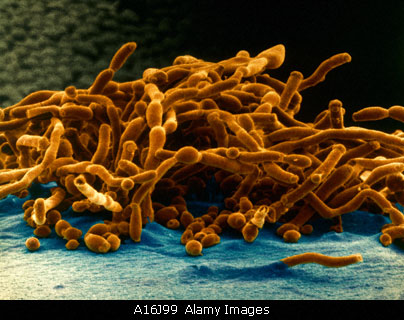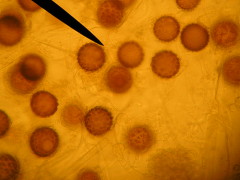|
Analysis of Candida
Albicans as a Fungus
[Taken from writings of Dr.
Simoncini but reduced to
less medical and more commonly understood words.]
Candida Albicans is a type of
fungus.
microscopic photo of
Candida Albicans

Fungi possess a
property that is strange when compared to all other
micro-organisms: the ability to have a basic microscopic
structure (the fiber-like hypha) with a simultaneous tendency
to grow to remarkable dimensions (up to several kilograms),
keeping unchanged the capacity to adapt and reproduce.
From this point of
view, therefore, fungi cannot be considered true organisms,
but unique cellular parts with the behavior of an organism.
Fungi, during their
life cycle, depend on other living beings, which must be
exploited in different degrees for their feeding. The simple
carbohydrates (sugars) needed by fungi include monosaccarides
(glucose, fructose, and mannose). The fungi get these sugars
from their hosts by feeding on their oragnic waste, and by
directly attacking the host for nourishment.
Fungi show a great
variety of reproductive manifestations (sexual, asexual,
gemmation; these manifestations can often be observed
simultaneously) in order to create spores.
The hyphas somewhat
beak-shaped fiber structures allow their penetration of the
host tissues.

The production of
spores can be so abundant as to always include tens, hundreds,
and even thousands of millions of them.
Spores have an
immense resistance to external aggression, for they are
capable of staying dormant in adverse conditions for many
years, while maintaining their regenerative potential.
The shape of the
fungus is never defined, for it is imposed by the environment
in which the fungus develops.
The partial or total
substitution of nourishing substances causes frequent
mutations in fungi, and this is further proof of their high
adaptability.
When the nutritional
conditions are precarious many fungi join with nearby fungi
which allows them to explore the available tissue more easily,
using more complete physiological processes. This property,
which substitutes co-operation for competition, makes them
distinct from any other microorganism, and for this reason
Buller calls them social organisms.
When a fungus cell
gets old or becomes damaged (i.e. by a toxic substance or by a
drug) many fungi, whose intercellular dividing walls are
provided with a pore, react by transfering the nucleus and
cytoplasm of the damaged cell into a healthy one, thus
conserving unaltered all their biological potential.
The phenomena
regulating the development of hyphas is independent of the
regulating action and behaviour of the rest of the colony.
Fungi are capable of
implementing an infinite number of modifications to their own
metabolism in order to overcome the defense mechanism of the
host. These modifications are implemented through plasmatic
and biochemical actions as well as by a size increase and
reproduction of the cells that have been attacked.
Fungi are so
aggressive as to attack not only plants, animal tissue, food
supplies and other fungi, but even protozoa, amoebas and
nematodes.
Fungi hunt
nematodes, for example, with peculiar hyphal modifications
that constitute real mycelial fiber criss-cross, viscose, or
ring traps that achieve the immobilization of the worms. In
some cases, the aggressive power of fungi is so great as to
allow it, with only a cellular ring made up of three units, to
tighten in its grip, capture and kill its prey in a short time
notwithstanding the prey's desperate struggling.
From the short
notations above, therefore, it seems fair to dedicate a
greater attention to the world of fungi, especially
considering the fact that biologists and microbiologists
constantly highlight large deficiencies and voids in all their
descriptions and interpretations of the fungi's shape,
physiology and reproduction.
The fungus is the
most powerful and the most organized micro-organism known.
The greatest disease
of mankind may therefore hide within the small cluster of
pathogenic fungi, and may be after all be located with just
some simple deductions able to close the circle and provide
the solution.
Therefore an
exceptionally high and diversified pathogenic potentiality
exists in this fungal fiber of just a few microns in size,
which, even though it cannot be traced with present
experimental instruments, cannot be neglected from the
clinical point of view. Certainly, its present disease
classification cannot be satisfactory, because if we do not
keep the possibly endless parasitic configurations in mind,
that classification is too simplistic and constraining.
We therefore have to
hypothesize that Candida, in the moment it is attacked by the
immune system of the host or by a conventional antifungal
treatment, does not react in the usual, predicted way, but
defends itself by transforming itself into ever-smaller and
non-differentiated elements that maintain their prolific
reproductiveness intact to the point of hiding their presence
both to the host organism and to possible diagnostic
investigations.
The Candida's
behavior may be considered to be almost elastic:
When favourable
conditions exist, it thrives on epithelium (a surface such as
the inner surface of intestines); as soon as the tissue
reaction is engaged, it massively transforms itself into a
form that is less productive but impervious to attack -- the
spore.
Candida spores

If then continuous
sub-surface anti-fungal solutions take place coupled with a
greater reactivity, in that very moment the spores go deeper
into the lower connective tissue in a well defended impervious
state.
In this way, Candida
is free to expand to maturation in the soil, air, water,
vegetation, etc., that is, wherever there is no antibody
reaction.
In the epithelium,
instead, it takes a mixed form, that is reduced to the sole
spore component when it penetrates in the lower epithelial
levels, where it tends to expand again.
Candida has been
studied only in a pathogenic context, that is, only in
relation to the epithelial tissues. In reality Candida
possesses an aggressive ability that is diversified in
response to the target tissue. It is just in the connective or
in the connective environment, in fact, and not in the
differentiated tissues, that Candida may find conditions
favourable to an unlimited expansion. This emerges if we stop
and reflect for a moment on the main function of connective
tissue, which is to convey and supply nourishing substances to
the cells of the whole organism. This is to be considered as
an environment external to the more differentiated cells such
as nervous, muscular, etc. It is in this context, in fact,
that the competition for food takes place. On one hand we have
the organism's cellular elements trying to defeat all forms of
invasion; on the other hand, we have fungal cells trying to
absorb ever-growing quantities of nourishing substances.
Candida goes deeper
into the sub-epithelial levels from which it can be carried to
the whole organism through the blood and lymph (intimate
mycosis). Stages one and two are the most studied and known,
while stage three, though it has been described in its
morphological diversity, is reduced to a silent form of
saprophytism (obtaining food by absorbing dissolved organic
material).
This is not
acceptable from a logical point of view, because no one can
demonstrate the harmlessness of the fungal cells in the
deepest parts of the organism. In fact, the assumption that
Candida can behave in the same saprophytic manner that is
observed on epitheliums when it has successfully penetrated
the lower levels is at least risky.
In fact, we ask you
to not accept the theory that the connective environment is
(a) not suitable to nourish the Candida, but also at the same
time to not accept (b) the belief in the omnipotence of the
body's defense system towards an organic structure that is
invasive but that then supposedly becomes vulnerable once
lodged in the deeper tissues.
As to point a), it
is difficult to imagine that a micro-organism so able to adapt
itself to any sub-strata cannot find elements to support
itself in the human organic substance; by the same token, it
seems risky to hypothesis that the human organism's defense
system is totally efficient at every moment of its existence.
Finally, the
assumption that there is a tendency toward a state of
vulnerability in the case of this pathogenic fungus -- the
most invasive and aggressive microorganism existing in nature
-- seems to carry a whiff of irresponsibility.
It is therefore
urgent, on the basis of the above-mentioned considerations, to
recognize the hazardous nature of such a pathogenic agent,
which is capable of easily taking on a variety of biological
configurations, both biochemical and structural, in response
to the current environment of the host organism.
The fungal expansion
in fact becomes greater as the host tissue becomes less
nutritious to the candida, and thus less reactive against it.

|